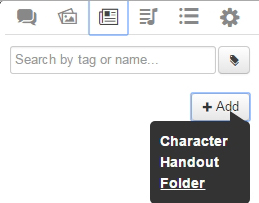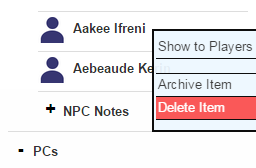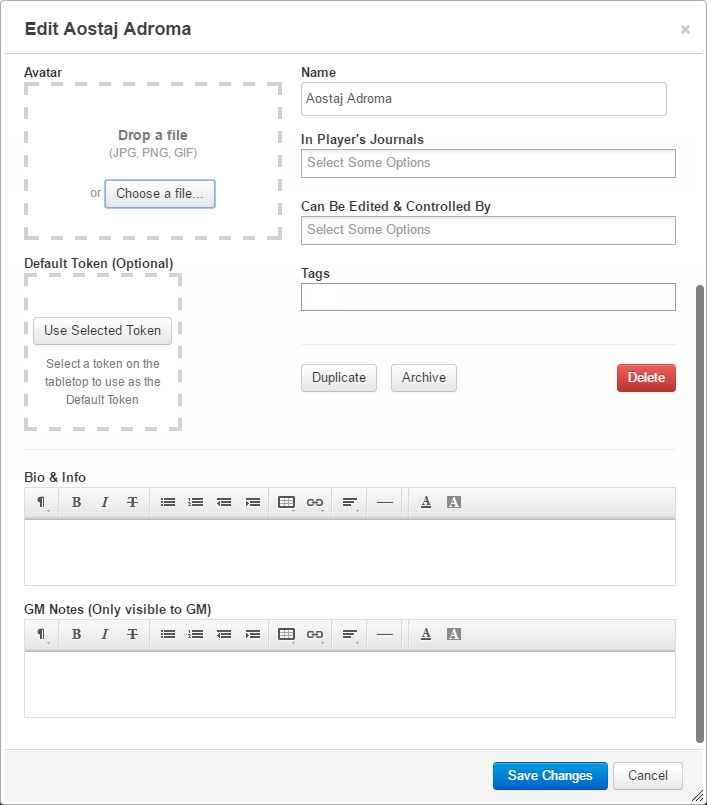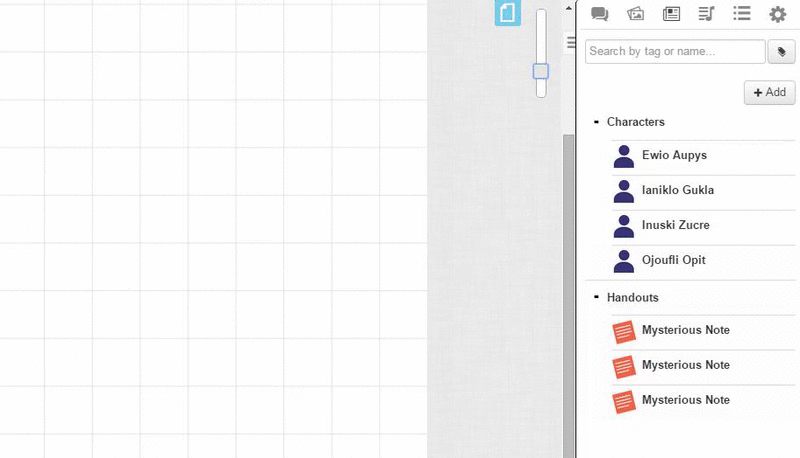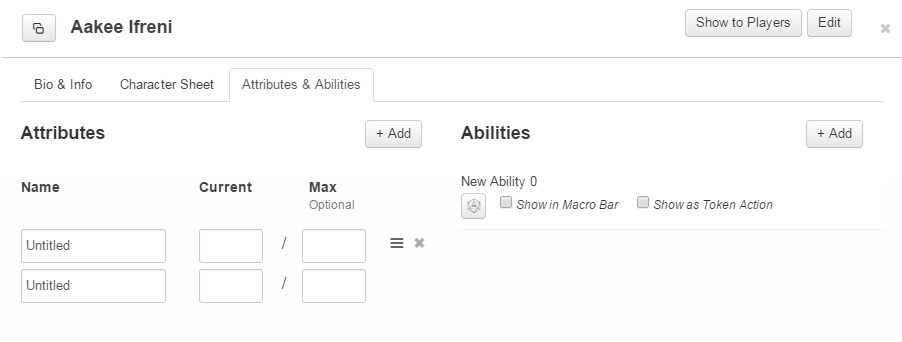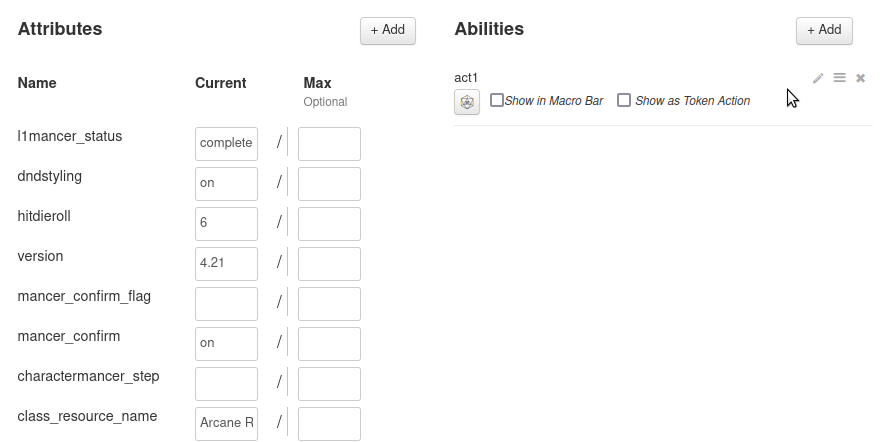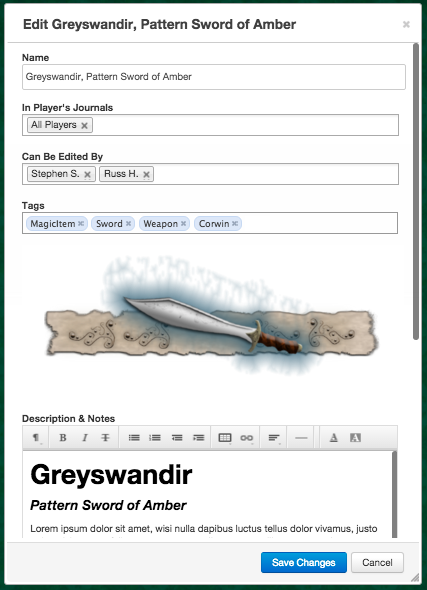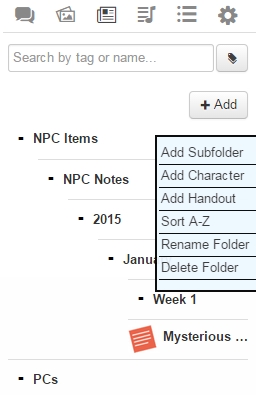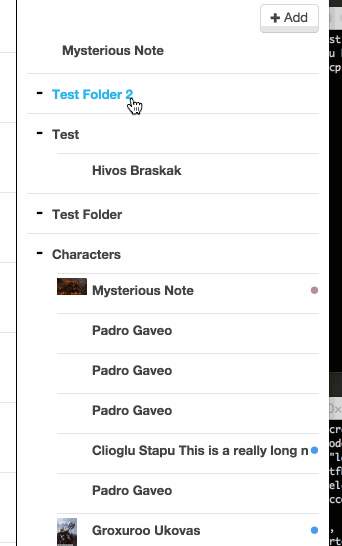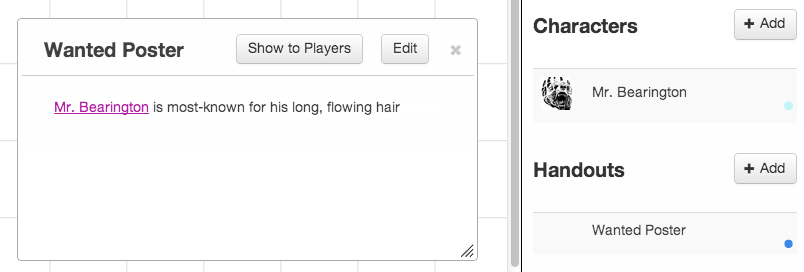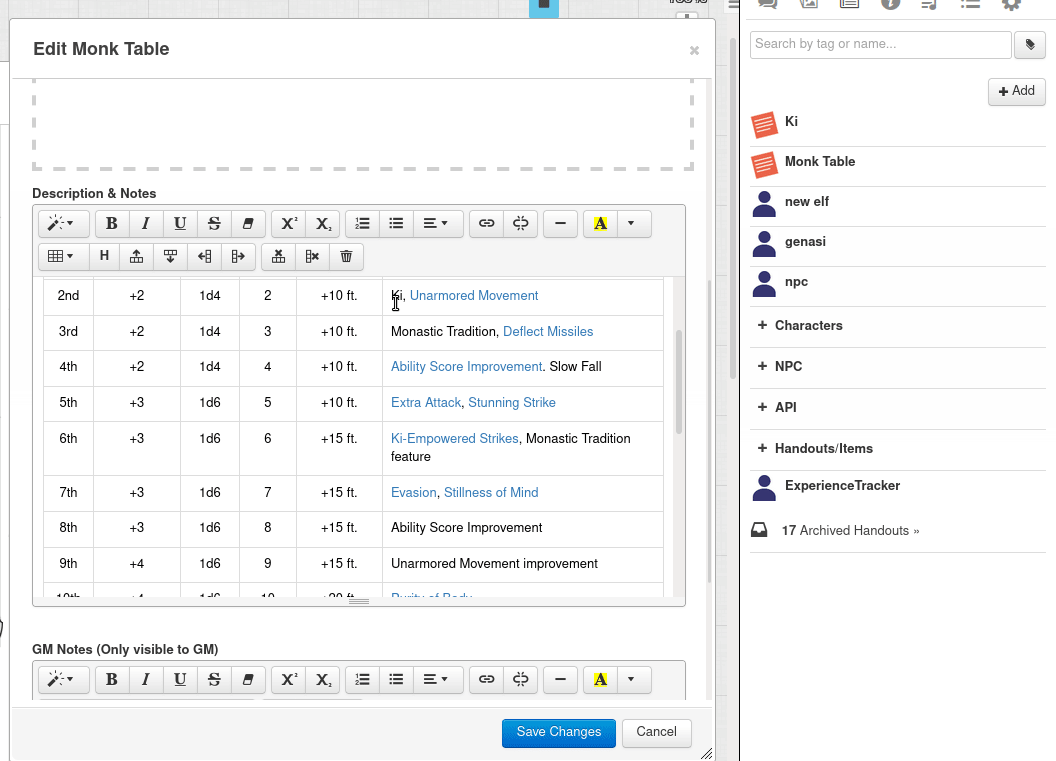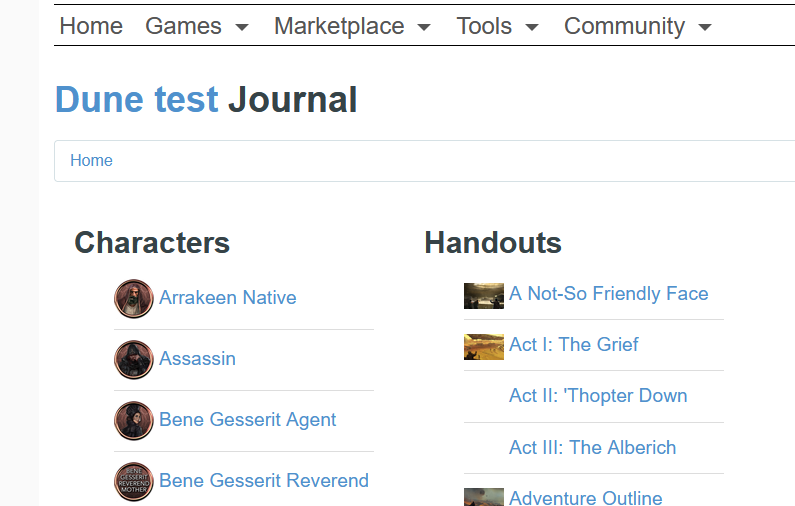Difference between revisions of "Journal"
From Roll20 Wiki
m (→External Journal Access) |
Andreas J. (Talk | contribs) m |
||
| (132 intermediate revisions by 15 users not shown) | |||
| Line 1: | Line 1: | ||
| − | + | {{revdate}}{{HCbox| {{hc|articles/360039675133-Journal Journal}} }} | |
| − | + | ||
| − | + | {{SidebarNav}}The {{Journal}} is the third tab of the [[Sidebar]]. | |
| − | [[ | + | |
| − | + | This feature allows [[GM|GMs]] to create '''[[#Characters|Characters]]''' and '''[[#Handouts|Handouts]]'''. | |
| − | [[ | + | |
| − | + | ||
| − | + | {{cleanup-msg|Images need updating, & adding characters/handouts are separate buttons. |Aug 2023}} | |
| − | + | ||
| − | + | The Journal serves as a central repository for all of your game's information. These items can be made private or shared with other [[players]]. Shared items can be viewed by players with access from this same tab. | |
| − | + | ||
| − | + | ||
| + | [[File:The_Journal_Tab.png|right|thumbnail|The '''Journal'''-tab on the [[Sidebar]]|400px]] | ||
| + | {{#evp:youtube|hLELEovjrDQ|Characters, Handouts, and Folders|right|400}} | ||
| − | + | = Add new Character/Handouts = | |
| + | [[File:Journal1.0.jpg|thumb|The Add button in the Journal Tab|right|400px]] | ||
| + | '''Only [[GM|Game Masters]] can Add Characters & Handouts into a game.''' | ||
| − | + | Add a new Character in-game is by navigating to the {{Journal}}-tab, and clicking on the {{button|<big>'''+'''</big> Add|white}}-button and select '''Character''' from the dropdown menu. | |
| − | + | The GM need to create the Character & then assign [[players]] both "In Journal" & "Controlled by" for them to see it & have full control over it. | |
| − | + | You can also add a character/handout by right-clicking an existing folder in the {{Journal}}-tab and selecting '''Add Character''' from the '''[[Journal#Folder_Options|Folder Options]]''' menu. Adding new '''Characters''' or '''Handouts''' using the right-click method places them directly into the right-clicked folder. | |
| − | + | ||
| − | + | '''Characters''' will be created with a random name, and '''Handouts''' will be named "Mysterious Note" by default. | |
| + | A Character Entry uses this icon:[[File:Character Entry Default Thumb.png|x]] as the default thumbnail for itself on the {{Journal}}-Tab. This thumbnail icon will change if you add an image to the Character's [[#Avatar|Avatar]]/Portrait. | ||
| + | <br clear="all" /> | ||
| − | + | = Characters = | |
| − | + | {{main|Character}} | |
| − | + | {{:Character}} | |
| − | = | + | = Handouts = |
| − | + | {{main|Handouts}} | |
| − | + | {{:Handout}} | |
| − | + | ||
| − | = | + | = Folders = |
| − | + | [[File:Journal3.1.jpg|frame|right]] | |
| + | Folders can be used to help organize '''Characters''' and '''Handouts''' within the Journal. Folders and the complete folder structure can be seen by all players who join the game as well as the GM, assuming there is at least one item in each folder for which players have available to their journals. If a folder contains items that are only available to the GM's journal, the players will not see that folder. | ||
| − | + | ==Add Folder== | |
| − | + | Add a new folder using '''+ Add''' button as described at the top of this page, making sure to select '''Folder''' from the dropdown menu. Follow the instructions on the prompt to name the folder and hit '''OK''' to add the folder to the Journal. | |
| − | + | ||
| − | == | + | == Folder Options == |
| − | + | Right click the folder to reveal a list of options. Add '''Subfolders''', '''Characters''', and '''Handouts''' using this method to automatically nest 4 additional folders under the right-clicked folder. Items can also be moved in and out of folders manually using the mouse, see '''[[Journal#Reorganizing_Journal_Items|Reorganizing Journal Items]]''' for more detail. | |
| + | {{mbox | text = '''Note:''' Due to the limited space on the Sidebar, only 3 additional folders can be added. '''Characters''' and '''Handouts''' can only be added to the most deeply nested folder by using the right-click options menu to add items.}} | ||
| − | |||
| − | |||
| − | + | You can sort alphabetically, rename or delete the folder from this menu as well. Deleting folders will '''not''' delete the items inside. All items in the deleted folder will be moved to the root folder. Using the '''Delete Folder''' option requires your approval upon use, confirm when prompted to initiate your action. | |
| − | |||
| − | |||
| − | == | + | == Reorganizing Journal Items == |
| − | + | [[File:Journal3gif.gif|left|frame]] | |
| − | + | :'''1.''' Hover your mouse over the item you wish to move.<br> | |
| − | + | :'''2.''' Grab the {{button|{{3lines}}|white}} that shows up along the left-side of the item name.<br> | |
| − | + | ||
| − | + | ||
| − | + | ||
| − | + | ||
| − | + | ||
| − | + | ||
| − | + | ||
| − | + | ||
| − | + | ||
| − | + | ||
| − | + | ||
| − | + | ||
| − | + | ||
| − | + | ||
| − | + | ||
| − | + | ||
| − | + | ||
| − | + | ||
| − | + | ||
| − | + | ||
| − | < | + | |
| − | + | ||
| − | + | ||
| + | :'''3.''' Drag the item just below the folder that you want to move it to and then move the file to the right before dropping it in the folder. | ||
<div style="clear: both;"></div> | <div style="clear: both;"></div> | ||
| − | ==== | + | == Minimizing Journal Entries == |
| + | [[File:MinimizedJournals.jpg|right|border|400px]] | ||
| − | + | You can minimize journal entries by double clicking upon any currently opened character journal or handout. This will shrink the item down to a small translucent title bar with the name of the entry on it and a couple buttons listed on the bar’s right side. You can click and drag this title bar to wherever is most convenient on the browser. To maximize the journal entry again, simply double click on the minimized title bar. | |
| − | + | While minimized, the Edit button is still available to access for both character journals and handouts. In the case for handouts, there’s also a “Show To Players” button option. | |
| − | + | You can close minimized journal entries by clicking on the X button on the far right of the title bar. | |
| − | + | {{notebox|'''Note:''' If you close a minimized journal entry it will remain so when you open it again from the Journal Tab on the Sidebar.}} | |
| − | + | ||
| − | == | + | =Journal Options= |
| − | + | ||
| − | == | + | == Link Between Journal Entries == |
| − | + | [[File:Journallinkss.png|540px|right]] | |
| + | You can easily create links between your Journal Entries(Handouts & Characters). | ||
| − | + | Put single brackets around the name of a character or handout (for example: <code>“[Mr. Bearington] is most-known for his long, flowing hair”</code>), and when you save the entry, it will automatically create a clickable link to the other journal entry. Links to other handouts are purple, while links to compendium entries or other hyperlinks are blue. | |
| − | |||
| − | + | It works both inside and outside the app, and it’s smart enough to obey [[player]] permissions as well (so a player can’t open a handout they don’t have access to, even if they see a link to that handout). | |
| − | [[ | + | You can use the links in [[#Bio_.26_Info_Tab|character bio]], GM notes (both for characters and [[tokens]]), and for handouts in the '''Description & Notes'''-field. Use links to tie entries together, or even create a “table of contents” page for your game to quickly access your most-used journal items. |
| − | + | [[File:Link-handouts.gif|thumbnail|center|800px|Example of creating a link from one journal entry to another, and using it to open the other handout.]] | |
| − | If | + | ==Linking to a Compendium Page== |
| + | If your game uses a {{Compendium}}, links to that compendium in handouts and character sheets will automatically open a handout from the in-app compendium. Use the full URL in the link in the text editor, including the <code>https://</code> part of the URL, but do not include bookmarks and arguments (anything that's after a <code>?</code> or <code>#</code> in a copied URL). | ||
| − | + | If you access the [[External Compendium]], you can search and navigate to the pages you want and simply copy the URLs from the address bar. | |
| − | + | {{ex}} | |
| − | + | To link to the [[5E|D&D 5E]] Rogue's compendium page, save the following as the link in the handout: <code><nowiki>https://roll20.net/compendium/dnd5e/Classes:Rogue</nowiki></code> | |
| − | == | + | == Journal Command Buttons == |
| − | [[ | + | {{#evp:youtube|pkDC-nP3vCE|Running Commands from Handouts by Nick Olivo|right|400}} |
| + | Within the [[Journal#Bio_.26_Info_Tab|Bio & Info]] and [[Journal#GM_Notes_Field|GM Notes]] text fields of a Character, or the [[Journal#Description_.26_Notes|Description & Notes]] and [[Journal#GM_Notes_.28GM_Only.29|GM Notes]] text fields of a Handout, you can create '''Journal Command Buttons'''; special hyperlinks that can output macros to the Text Chat when clicked. | ||
| − | + | Here's how to create a Journal Command Button within one of the aforementioned fields: | |
| + | # Insert a link using the link button on the redactor toolbar. | ||
| + | # At the very start of the "URL" field of the Link Window, type a backtick character: <code>`</code> | ||
| + | # Add in your macro code after the <code>`</code> character. | ||
| + | # Give your Journal Command Button a label using the "Text" field. | ||
| + | # Press the "Insert" button and Save Changes; you have created a Journal Command Button! | ||
| + | <br> | ||
| − | + | Another way to create Journal Command Buttons is to copy and paste an [[API:Chat#API_Command_Buttons|API Command Button]] or [[Macros#Ability_Command_Buttons|Ability Command Button]] from the Text Chat into one of the aforementioned text fields. | |
| − | + | '''Note:''' Journal Command Buttons will not work if you have the [[My_Settings#Use_Window_Popouts_for_Characters|Use Window Popouts for Characters]] option enabled. | |
| − | [[ | + | |
| − | + | ==[[Linking Tokens to Journals|Linking Characters & Tokens Together]]== | |
| − | + | You can take [[token]] assignments one step further by [[Linking Tokens to Journals|linking tokens to a Character Journal]]. | |
| − | + | ||
| − | + | ||
| − | You can | + | |
| − | + | ||
| − | + | ||
| + | ===For PCs or Named NPCs=== | ||
| + | The following setup is ideal for tokens that represent a single character, whether that's a player character or a prominent villains (i.e. not meant for stock monsters or creatures). | ||
| + | #Before linking the token to your character journal, open up its Token's Settings window by double clicking on the token, or clicking on the gear icon.<br /><br /> | ||
| + | #Select the desired Character Name for this token from the drop down menu for "Represents Character". This drop down menu lists every available character journal entry in alphanumerical order.<br /><br /> | ||
| + | # For Bars 1, 2, and 3, click on the adjoining drop down menus to choose the relative attribute fields of the character journal. This will include ones you've created and ones that may be used by a Character Sheet (if applicable). A character's current HP value is a good candidate or any other attribute that you want be convenient to track.<br /><br /> | ||
| + | # Save your changes and close the Token Settings window | ||
== External Journal Access == | == External Journal Access == | ||
| + | {{main|External Journal}} | ||
| − | + | {{:External Journal}} | |
| + | <br clear=all> | ||
| − | + | =Archive= | |
| + | {{main|Archiving}} | ||
| − | + | The '''Archive Handout''' button will move the '''Handout''' to a special area where it will no longer show up in the '''Journal Listing''' or in results from the '''Search''' field or '''Tag List Dropdown'''. Archived handouts can be accessed in the '''Archived Handouts Dialog''' at the bottom of the '''Journal Listing''', and can be restored there. | |
| − | + | {{orange| Archiving characters & handouts will not improve game performance, see [[Optimizing Roll20 Performance]]}} | |
| − | + | ||
| − | + | ||
| − | + | [[Pro]] users can use the [[Transmogrifier]] to move characters & handouts to a separate [[Library Campaign]], to reduce the load if you have hundreds of unused characters. | |
| − | + | =Tips= | |
| + | * If you want to search through a handout or character using {{button|Ctrl}}+{{button|F}}, you can do so by either: | ||
| + | ** [[Journal#Pop-Out_Button|pop out]] it in a separate window. In Roll20, {{button|Ctrl}}+{{button|F}} opens <span style="font-family:Pictos Custom;">i</span> [[Drawing_Tools#Freehand|Freehand Drawing Tool]] | ||
| + | ** (Game hosted by Plus/Pro) View Handouts in [[External Journal]] | ||
| + | ** {{fpl|5250301/ Search}} API(Pro only) can be used to find matches from all handouts in the game | ||
| − | + | =API= | |
| + | {{Pro only|section}} | ||
| + | ==Characters== | ||
| + | {{:Character Sheet/API}} | ||
| − | + | ==Handout== | |
| + | {{:Handout/API}} | ||
| − | + | =See Also= | |
| + | * [[Character Sheet]] | ||
| + | ** [[Link Token|Linking Token to Character Sheet]] | ||
| + | ** [[Character Vault]] | ||
| + | ** [[Transmogrifier]] | ||
| + | * [[Game Management]] | ||
| + | The other tabs in the [[Sidebar]]: | ||
| + | * {{Text Chat}} | ||
| + | ** [[Complete Guide to Macros & Rolls]] | ||
| + | * {{Art Library}} | ||
| + | * {{Journal}} | ||
| + | ** [[Character Sheets]] | ||
| + | * {{Compendium}} | ||
| + | * {{Jukebox}} | ||
| + | * {{Collections}} | ||
| + | ** [[Macros]] | ||
| + | ** [[Playing Cards]] | ||
| + | ** [[Rollable Tables]] | ||
| + | * {{My Settings}} | ||
| + | ** [[Advanced Shortcuts|Advanced Keyboard Shortcuts]] | ||
| + | <br> | ||
| + | <br> | ||
[[Category:Docs]] | [[Category:Docs]] | ||
| + | [[Category:Sidebar]] | ||
| + | [[Category:Character Sheets]] | ||
Latest revision as of 04:56, 10 August 2023
Page Updated: 2023-08-10 |
Attention: This page is community-maintained. For the official Roll20 version of this article, see the Help Center for assistance: Journal .
Sidebar
q Text Chat
P Art Library
N Journal
i Compendium
u Jukebox
l Collections
y My Settings
The N Journal is the third tab of the Sidebar.
This feature allows GMs to create Characters and Handouts.
| Images need updating, & adding characters/handouts are separate buttons. (Aug 2023) |
The Journal serves as a central repository for all of your game's information. These items can be made private or shared with other players. Shared items can be viewed by players with access from this same tab.
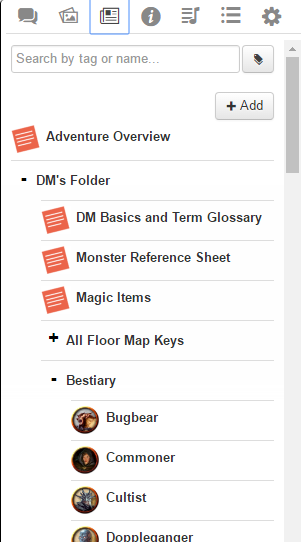
Contents |
[edit] Add new Character/Handouts
Only Game Masters can Add Characters & Handouts into a game.
Add a new Character in-game is by navigating to the N Journal-tab, and clicking on the + Add-button and select Character from the dropdown menu.
The GM need to create the Character & then assign players both "In Journal" & "Controlled by" for them to see it & have full control over it.
You can also add a character/handout by right-clicking an existing folder in the N Journal-tab and selecting Add Character from the Folder Options menu. Adding new Characters or Handouts using the right-click method places them directly into the right-clicked folder.
Characters will be created with a random name, and Handouts will be named "Mysterious Note" by default.
A Character Entry uses this icon:![]() as the default thumbnail for itself on the N Journal-Tab. This thumbnail icon will change if you add an image to the Character's Avatar/Portrait.
as the default thumbnail for itself on the N Journal-Tab. This thumbnail icon will change if you add an image to the Character's Avatar/Portrait.
[edit] Characters
Main Page: Character
Character Journal entries are intended to represent either PCs, NPCs, or anything else that might take advantage of the various features Character Journals have, such as: Character Sheets, Linked Tokens, and Attributes and Abilities macros.
[edit] Character Right-Click Options
While inside the Journal Tab, right-click the Character's Name to reveal the following options:
- Show to Players: This will force the Character Window to open on your players' Roll20 client for them to view. If your players don't already have permissions assigned yet to view this entry, Roll20 will ask you to confirm whether you want to show the entry to everyone.
- Archive Item: The Journal tab has an archival system, so you can store Character and Handout entries away when not needed for play. This can help with keeping your Journal tab organized. Archiving a Character will remove it from view in the Journal tab and place it in the Archive that is displayed at the bottom of the tab as soon as a single item is placed in it.
- Note: an archived Character still loads at game startup, it's only hidden from view. Archiving Characters does not reduce load on campaign. Proinfo users have the option of using the Transmogrifier to move unused characters to & from a storage campaign.
- Note: an archived Character still loads at game startup, it's only hidden from view. Archiving Characters does not reduce load on campaign.
- Delete Item: This will permanently remove the Character entry from the Journal Tab. This can't be undone, so Roll20 will ask for confirmation before initiating the deletion.
[edit] The Character Window
Click the Character entry's Name from the N Journal-tab to open it.
[edit] The Character Window Header
At the left hand corner is the ![]() Character Popout Button. Click this to pop this Character Window out into a new browser window. This can come in handy if you're a GM or Player who uses multiple monitors. Visit the My Settings page to set popout windows to automatic. Click the Show to Players button to reveal the Character to all players or click the "Edit" button to customize.
Character Popout Button. Click this to pop this Character Window out into a new browser window. This can come in handy if you're a GM or Player who uses multiple monitors. Visit the My Settings page to set popout windows to automatic. Click the Show to Players button to reveal the Character to all players or click the "Edit" button to customize.
To the right of the Journal Popout Button is the entry's Character Name. This is the display name for this journal entry and what you will see if you wish to refer to it elsewhere in the game like a macro, Chat As, or Token Representation.
On the right hand side of the Character Window are the following row of four buttons: ![]()
1. Show to Players Button: Clicking on this button behaves the same way as the earlier mentioned Journal Entry Right-Click Option Menu.
| Allow a Player to view, edit, and control a Character and Character Sheet, click the Edit button and add the Player or Players names to in Player's Journal and Can be Edited and Controlled by fields, finally click Save. |
3. Zoom Options Button: Clicking on this button gives you ability to increase or decrease the zoom of all content within the Character Window. At default, the zoom is set at 100%. This affects the view of all tabs within this window.
4. Close Window Button: Clicking on the X icon at the top right corner of the window will close it if you are in View Mode. If you are in Edit Mode, Clicking on the X button will revert you back to View Mode.
[edit] Edit
Only the GM can access the sheet Edit Mode
- In Player's Journals: By default, only the GM sees Characters in to the N Journal-tab. To allow other Players to see the Character in their N Journal, add their names to the "In Player's Journals"-field. Player names are only available once they've launched the game at least once. You can also choose "All Players" to allow everyone to view the Character.
Players who can view the Character will see the Name, Avatar, and any text typed in the Character's Bio & Info field only. They will not have access to the Character Sheet-tab (if applicable) nor the Attributes and Abilities-tab.
- Can Be Edited & Controlled By: Adding players to "The Controlled By" field gives them the following permissions:
- They will be able to choose the Character from the "Speak As" drop down menu in the q Text Chat-tab.
- They will be able to edit the Character's Name, Bio-text field of the Bio & Info- tab.
- If the game uses a Character Sheet, they will have permission to view AND edit information on Character Sheet-tab.
- They will be able to control any Token set to Represent this Character. See Linking Token to Character Sheet-guide for more details.
You can also choose "All Players" to allow everyone to control or edit the Character entry.
- They will be able to choose the Character from the "Speak As" drop down menu in the q Text Chat-tab.
- Tags: The Tags field allows you add Tags to the Character entry so that you can quickly find it later using the Search box at the top of the Journal tab on the Sidebar.
- Duplicate: Using the "Duplicate"-feature will create a duplicate of the current Character entry on the N Journal-tab with the name "Copy of (original-character)". This can be useful when using a Character entry as a template for new Character entries.
- Archive: This button behaves exactly as the Right Click Option in the Journal Tab. Archiving the Character will put it in long-term storage. Once you've archived at least one Character or Handout entry, an Archive icon will appear at the bottom of the Journal Tab.
- Delete: Deleting the Character will permanently remove it from the Game. This cannot be undone!
[edit] Avatar
The Avatar, (aka. Character Portrait), is an image that represent this Character in the Journal listing (it replaces the default thumbnail) as well as the Chat interface. Drag and drop an image from your computer, use the Choose a file...-button to select the image from a file explorer, or drag and drop an image from the Art Library into the box. Once an image is added, you can remove it at any time by hovering your mouse over the Avatar area and clicking on the Remove link that appears in the upper right of the square.
[edit] Default Token
The Default Token field gives you the ability to select a token on the tabletop to use as the default token for this Character whenever it is added to the table. Just select a token on the Tabletop, then press the "Use Selected Token" button. A copy of the token will be stored, including any notes, player permissions settings, and bar values and links. A GM or a player that can Edit and Control this Character can then drag-and-drop the Character from the Journal listing in the right sidebar onto the tabletop, and a new copy of the Character's default token will be added to the table.
Once a Token is tied to a Character in the Journal, a Shift+Click on the Settings icon when a token is selected or Shift+Double Click on the token directly will open the attached Character; Alt+Click opens the character to the Attributes & Abilities tab. You can also drag and drop the character name from the N Journal-tab to add tokens directly to the tabletop, once a token has been linked to it's Character. To drag-n-drop a character/token from the N Journal, you need to select its name, not the character icon/three bar. If you select the icon (or three horizontal bars) to the left of the name, it will move the character's position in the Journal.
| Useful Tip: For PCs, set up all your tokens ahead of time and assign them to their respective PC Character entries. Then when your Players join your game, just give them control of the Character and they'll be able to control all the tokens for that Character right away. Please see the Linking Token to Character Sheet-guide for further details. |
[edit] Character Tabs
The Character Window will either have two or three tabs of content depending on whether your game is using a Character Sheet. They are listed in this order:
- Bio & Info Tab: This tab is where you edit the basics of the Character entry from Name, to its assigned Token, User Permissions, as well as a place to take PC and GM notes.
- Character Sheet (optional): If your game is using a community or Roll20 created Character Sheet, it will show up on this tab.
- Attributes & Abilities: This tab is where you can create custom attributes and macros to roll dice formulas from. (Note: If you're using a Character Sheet, there will already be Ability fields created to be used by the Sheet.)
The following sections will go over each tab in detail.
[edit] Bio & Info Tab
- Name: This will change the Character Name for this Entry.
- Bio & Info Field: The Bio & Info field allows you to input information about the Character.
- GM Notes Field: Use the GM Notes area to add additional notes that only the GM can see.
| Note: Both Bio and GM Note fields have text formatting options available, as well as, the ability to add tables and copy and paste from PDFs or other Word Documents. |
[edit] Character Sheet Tab
Main Page: Character Sheet
Your Character may also have a Character Sheet-tab, which is a way to display information about the character which mimics a paper character sheet for the game you are playing. Your GM will set this feature up if it's available for your game. Filling out the sheet is usually fairly straightforward, just click on any text/number-field, and enter your information. Some fields will also auto-update based on other information (for example, your Strength Modifier may auto-calculate based on the Strength of your Character). Finally, Character Sheets often have roll buttons which you can click to quickly perform skill checks and other actions (such as attacks) for your Character.
The complexity and sophistication between different character sheet templates can vary a lot, from being a simple digital version of the game's paper sheet where you just use it for storing simple info and numbers, going all the way to to having integrated character creation tools, i Compendium-compatibility, detailed settings, and options to customize the sheet and dice rolls made from it.
Roll20 have a massive number of option from sheets to use for game systems. Sheets that have by Roll20 in their name (~15 sheets) are created and maintained by Roll20, but the majority of sheets (several hundreds) are created & maintained by the community. A number of sheets are maintained by publishers themselves.
Related:
[edit] Attributes & Abilities Tab
The Attributes & Abilities Tab is used to track the Attributes of the Character if you don't use any Character Sheet template, or want a custom stat, and store rolls and other chat commands that could be used by that Character.
[edit] Attributes
| Note: If you have a Character Sheet-tab, you seldom( or never) need to edit any Attributes on the A&A-tab, as it can interfere with how the visual sheet functions. Most of the sheet's stats, apart from repeating sections, are mirrored there. |
You can add Attributes to your Character by clicking on the + Add Button in the Attributes column. Each Attribute requires a Name, as well as, a Current Value and an (optional) Max Value. Any players that you give permission to edit/control the Character entry will also be able to edit and add more Attributes. Attributes can be used as variables in Macros and Abilities.
Macro Creation
- Complete Guide to Macros & Rolls
- q Text Chat
- Dice Reference
- Order of Operations
- Macros
- Token Reference
- Character Reference
- Roll Templates
- Roll Table
Advanced
- Formatting
- HTML Replacement
- Chat Menus
- Hidden Rolls
- Advanced Macro Tips
- API Commands
- Char Sheet Creation
- External tools
Misc.
To call an Attribute within on the Character Sheet Tab or within an Ability-macro on the Attributes & Abilities Tab), it follow this format: @{AC}, @{level})
If you want to call a specific character's attributes in the q Text Chat or in a Macro, you need to specify the name of the character (e.g. @{Charlie|level}), or use:
- Selected Token with a Macro
@{selected|level} - Targeted Token with a Macro
@{target|level}
[edit] Abilities
| This section could do with a cleanup (March 2021) |
Abilities are designed to work in conjunction with Attributes, and work almost exactly as Macros.
You can input any valid chat command (rolls, emotes, etc.) into an Ability, and by using an Attribute that the character have as a variable, you can create complex Character-based Abilities.
When creating an Ability, type @ to view a list of Attributes that can be used. Since the variable used in the Ability is linked to a Character Attribute, the value will sync when changed in the Character editor.
You can easily add and remove Abilities from your Macro Quick-Bar by selecting the Character from the N Journal Tab.
Shift+Click on an Ability on the Macro Bar will open that Character's Ability editor. Abilities can also be used as Token Actions which is a token specific macro feature.
Abilities can be called directly from the chat by typing them similarly to an Attribute. The format is %{<character name>|<ability name}, for example: %{Bob the Slayer|Massive-Axe}
Finally, you can hover over Attributes and Abilities to drag and drop to re-order them or delete them.
Ability calls (e.g. %{Bob the Slayer|Massive-Axe}) always require a keyword (e.g. the Character Name keyword; "Bob the Slayer"), even within a tab of a Character Window. (e.g. %{Massive-Axe} won't work for Bob but %{selected|Massive-Axe} can.)
Ability Command Buttons can be used to call Abilities from the q Text Chat.
[edit] Handouts
Main Page: Handouts
Handouts are very similar to Characters, and have some of the same fields.
[edit] Handout Dialog
When you click on a Handout in the Journal Listing, it will open the Handout Dialog. This is where you view the contents of the Handout, including the Image (if one is associated), the Description & Notes text (if any has been entered) and the GM Notes (if the viewer is a GM).
If you include an image that's larger than the Handout Dialog, a magnifying glass will appear over the image when you view the Handout. Clicking on the image in the Handout Dialog will display either the original dimensions or a full-screen version of that image.
The Name of the Handout will be shown across the top of the Handout Dialog with several buttons:
[edit] Pop-Out Button
This button is to the left of the Name and looks like two overlapping rectangles. Clicking it will open the character/handout in a separate browser window from your primary Roll20 window, which can then be moved independently, viewed side-by-side with your Roll20 Game page, moved to a different monitor, or switched between with your operating systems native commands.
| See Character Sheet in a separate window for issues & limitations of character sheets when they are popped out. Some sheet features don't work when they are popped out. |
[edit] Show To Players Button (GM Only)
This button is to the right of the Name and allows the GM to cause the Handout Dialog to be displayed on the screens of any players that can View the Handout. If no players can View the Handout, a dialog will prompt the GM and ask if it should be shared with all players. Clicking Show to Everyone will insert All Players into the In Players's Journals field of the Handout (see below).
[edit] Edit Button
The GM always has this button, as do any players that can Edit the Handout because of inclusion in Can Be Edited By (see below). Clicking this button will move the Handout Dialog into the Editing view.
[edit] Editing
The Editing view of the Handout Dialog allows GMs and players who can Edit to make changes to the Handout.
Handout Editing & Formatting:
You can copy-paste content from outside Roll20 into the Editor, and the styling will stay, enabling you style your handouts, beyond the editor's normal tools.
[edit] Name
You can change the default text of Mysterious Note to whatever you like. This will be the title of the Handout in the Journal tab, and will show across the top of the Handout Dialog when it is opened.
[edit] In Player's Journals (GM Only)
Just like for Characters, the GM is the only person that can see a Handout by default. You can allow viewing by select players by putting their name in this field, or select All Players to allow access to all. Players with a Handout in their journal will be able to view it whenever they like. It will be shown in whatever folder the GM has put it in, complete with the name of the folder. You may want to move a handout before allowing your players to view it (For example, if it is in the Cursed Items folder).
You can also drag and drop a Handout from the Journal tab in the right sidebar onto a player. That player will be given permission to view the Handout, and it will also appear on their screen immediately.
[edit] Can Be Edited By (GM Only)
Similar to the In Player's Folder, by default only the GM can edit a Handout. Placing a player's name in this field allows that player to both View and Edit that Handout. This is particularly useful for allowing players journals or secret notes for correspondence with the GM. The same notes about folders apply as with the above.
[edit] Tags (GM Only)
The Tags field allows you to assign words to associate with this Handout which are useful for finding it later via the Search field or the Tag List Dropdown.
[edit] Image
You can upload an Image to represent this Handout in the Journal listing.
Either drag & drop an image from your computer, or drag a& drop an image from your P Art Library.
[edit] Description & Notes
This field lets you associate a freeform block of text with the Handout. This text is visible to players that can View the Handout and editable by players that can Edit the Handout.
[edit] GM Notes (GM Only)
This field is just like Description & Notes save that only the GM can edit and view it, regardless of other settings.
[edit] Duplicate Handout (GM Only)
The Duplicate-button creates a copy of the handout, named "Copy of (name of handout)", which will appear at the bottom of the journal. Multiple copies of the same handout will all be named "Copy of..." when created, though these can all be renamed as needed.
[edit] Archive Handout (GM Only)
The Archive-button will move the Handout to a special area where it will no longer show up in the Journal Listing or in results from the Search field or Tag List Dropdown. Archived handouts can be accessed in the Archived Handouts Dialog at the bottom of the Journal Listing, and can be restored there.
[edit] Delete Handout (GM Only)
The Delete Handout- button will prompt for confirmation and then permanently remove the Handout from the Game.
[edit] Folders
Folders can be used to help organize Characters and Handouts within the Journal. Folders and the complete folder structure can be seen by all players who join the game as well as the GM, assuming there is at least one item in each folder for which players have available to their journals. If a folder contains items that are only available to the GM's journal, the players will not see that folder.
[edit] Add Folder
Add a new folder using + Add button as described at the top of this page, making sure to select Folder from the dropdown menu. Follow the instructions on the prompt to name the folder and hit OK to add the folder to the Journal.
[edit] Folder Options
Right click the folder to reveal a list of options. Add Subfolders, Characters, and Handouts using this method to automatically nest 4 additional folders under the right-clicked folder. Items can also be moved in and out of folders manually using the mouse, see Reorganizing Journal Items for more detail.
| Note: Due to the limited space on the Sidebar, only 3 additional folders can be added. Characters and Handouts can only be added to the most deeply nested folder by using the right-click options menu to add items. |
You can sort alphabetically, rename or delete the folder from this menu as well. Deleting folders will not delete the items inside. All items in the deleted folder will be moved to the root folder. Using the Delete Folder option requires your approval upon use, confirm when prompted to initiate your action.
[edit] Reorganizing Journal Items
- 1. Hover your mouse over the item you wish to move.
- 2. Grab the ≡ that shows up along the left-side of the item name.
- 3. Drag the item just below the folder that you want to move it to and then move the file to the right before dropping it in the folder.
[edit] Minimizing Journal Entries
You can minimize journal entries by double clicking upon any currently opened character journal or handout. This will shrink the item down to a small translucent title bar with the name of the entry on it and a couple buttons listed on the bar’s right side. You can click and drag this title bar to wherever is most convenient on the browser. To maximize the journal entry again, simply double click on the minimized title bar.
While minimized, the Edit button is still available to access for both character journals and handouts. In the case for handouts, there’s also a “Show To Players” button option.
You can close minimized journal entries by clicking on the X button on the far right of the title bar.
| Note: If you close a minimized journal entry it will remain so when you open it again from the Journal Tab on the Sidebar. |
[edit] Journal Options
[edit] Link Between Journal Entries
You can easily create links between your Journal Entries(Handouts & Characters).
Put single brackets around the name of a character or handout (for example: “[Mr. Bearington] is most-known for his long, flowing hair”), and when you save the entry, it will automatically create a clickable link to the other journal entry. Links to other handouts are purple, while links to compendium entries or other hyperlinks are blue.
It works both inside and outside the app, and it’s smart enough to obey player permissions as well (so a player can’t open a handout they don’t have access to, even if they see a link to that handout).
You can use the links in character bio, GM notes (both for characters and tokens), and for handouts in the Description & Notes-field. Use links to tie entries together, or even create a “table of contents” page for your game to quickly access your most-used journal items.
[edit] Linking to a Compendium Page
If your game uses a i Compendium, links to that compendium in handouts and character sheets will automatically open a handout from the in-app compendium. Use the full URL in the link in the text editor, including the https:// part of the URL, but do not include bookmarks and arguments (anything that's after a ? or # in a copied URL).
If you access the External Compendium, you can search and navigate to the pages you want and simply copy the URLs from the address bar.
Example:
To link to the D&D 5E Rogue's compendium page, save the following as the link in the handout: https://roll20.net/compendium/dnd5e/Classes:Rogue
[edit] Journal Command Buttons
Within the Bio & Info and GM Notes text fields of a Character, or the Description & Notes and GM Notes text fields of a Handout, you can create Journal Command Buttons; special hyperlinks that can output macros to the Text Chat when clicked.
Here's how to create a Journal Command Button within one of the aforementioned fields:
- Insert a link using the link button on the redactor toolbar.
- At the very start of the "URL" field of the Link Window, type a backtick character:
` - Add in your macro code after the
`character. - Give your Journal Command Button a label using the "Text" field.
- Press the "Insert" button and Save Changes; you have created a Journal Command Button!
Another way to create Journal Command Buttons is to copy and paste an API Command Button or Ability Command Button from the Text Chat into one of the aforementioned text fields.
Note: Journal Command Buttons will not work if you have the Use Window Popouts for Characters option enabled.
[edit] Linking Characters & Tokens Together
You can take token assignments one step further by linking tokens to a Character Journal.
[edit] For PCs or Named NPCs
The following setup is ideal for tokens that represent a single character, whether that's a player character or a prominent villains (i.e. not meant for stock monsters or creatures).
- Before linking the token to your character journal, open up its Token's Settings window by double clicking on the token, or clicking on the gear icon.
- Select the desired Character Name for this token from the drop down menu for "Represents Character". This drop down menu lists every available character journal entry in alphanumerical order.
- For Bars 1, 2, and 3, click on the adjoining drop down menus to choose the relative attribute fields of the character journal. This will include ones you've created and ones that may be used by a Character Sheet (if applicable). A character's current HP value is a good candidate or any other attribute that you want be convenient to track.
- Save your changes and close the Token Settings window
[edit] External Journal Access
Main Page: External Journal
Located on the Game Details page, under the Content dropdown menu, along with access to your Chat Archive and Game Forums.
This is great for checking up on things in-between gaming sessions without the hassle of loading up the whole tabletop. You can also keep the External Journal open in a separate tab or browser window, or even on another screen.
The External Journal updates in real-time. So if a change is made to a character’s bio, you don’t need to reload, you’ll see the change right away. This really enables you to use the External Journal as a play aid during your Roll20 games.
Trick:
- If you have large handouts & need to search them for a certain word, you can open them in the External Journal and use
ctrl+Fto find it, where as you can't usectrl+Finside Roll20.- Search API(Forum) -- provides full text searching across handouts and characters (including attributes). Search respects permissions on handouts and characters.
[edit] Archive
Main Page: Archiving
The Archive Handout button will move the Handout to a special area where it will no longer show up in the Journal Listing or in results from the Search field or Tag List Dropdown. Archived handouts can be accessed in the Archived Handouts Dialog at the bottom of the Journal Listing, and can be restored there.
| Archiving characters & handouts will not improve game performance, see Optimizing Roll20 Performance |
Pro users can use the Transmogrifier to move characters & handouts to a separate Library Campaign, to reduce the load if you have hundreds of unused characters.
[edit] Tips
- If you want to search through a handout or character using Ctrl+F, you can do so by either:
- pop out it in a separate window. In Roll20, Ctrl+F opens i Freehand Drawing Tool
- (Game hosted by Plus/Pro) View Handouts in External Journal
- Search(Forum) API(Pro only) can be used to find matches from all handouts in the game
[edit] API
| This section is about a Roll20 feature exclusive to Pro-subscribers (and often to players in a Game created by a Pro-subscriber). If you'd like to use this feature, consider upgrading your account. |
[edit] Characters
Various scripts related to Character Sheets, and managing them.
- CharSheet -- Allow players to create their own character sheets.
- Welcome Package(Forum) -- API create and assigns character sheets to new people who join a game
- PlayerCharacters(Forum) -- Player & Character Manager. List all Player Characters divided by Player for the GM, or all assigned Characters for a Player. Add Characters for GM and Players.
- PublicSheet(Forum) -- Creates a "public" version of character sheets that players can't edit, which mirrors the actual character sheet.
- Reporter(Forum) -- A script to poll the game and return info on Token/Character pairs, along with customized action tools.
- Observer(Forum) -- Manages observer players, who are given the visibility (and control) of all player characters. This is useful for both podcasting views and local play on a single player screen.
[edit] Equipment
Most game systems have some form of equipment to make characters better. While scripts dealing with that equipment may necessarily be system-specific, there are scripts which handle equipment in a more general fashion.
- Ammo -- Provides inventory management for ammunition stored in an attribute of a character. Can be used with any char sheet
[edit] Attributes
Manipulate one or more characters' attributes. Anything that is system-specific should be placed in the system's category below; this section is for system-agnostic attribute manipulation.
- Ammo -- API for tracking ammo use & recovery.
- ChatSetAttr -- Create, modify, and delete character attributes via chat commands or macros. ChatSetAttr can be embedded into normal macros.
- GroupCheck -- A way to quickly roll a group check for everyone, and see who succeed
- ApplyDamage(Forum) -- Supplementary API to GroupCheck, which enables to automatically apply damage to a group of characters, based on failed/succeeded GroupCheck rolls. Example: Damage of an AoE Spell, based on success/fail on saving throw
- Conditions -- Track attribute-modifying conditions.
- EasyExperience -- Make awarding experience easy and choose your experience progression.
- LazyExperience(Forum) -- to record experience during a game. Inspired by EasyEx, biggest difference is that it has an option to reward experience directly.
- Easily Calculate Session XP with LazyExperience - Nick Olivo
- Experience Tracker -- (Note: Old API, not updated since 2016) Automatic tracking of a D&D 5e-like experience system, as well as level up announcement in chat.
!xphandles experience and announces level up.
[edit] Handout
API Scripts interacting with Handouts and Journal entries.
- Supernotes(Forum) -- script pulls the contents from a token's GM Notes field.
- If the token represents a character, you can optionally pull in the Bio or GM notes from the character. The user can decide whether to whisper the notes to the GM or broadcast them to all players.
- Finally, there is the option to add a footer to notes whispered to the GM. This footer creates a chat button to give the option of sending the notes on to the players.
- NoteLog(Forum) -- provides an easy interface to keeping notes for your players.
- Search(Forum) -- provides full text searching across handouts and characters (including attributes). Search respects permissions on handouts and characters.
[edit] See Also
The other tabs in the Sidebar:
- q Text Chat
- P Art Library
- N Journal
- i Compendium
- u Jukebox
- l Collections
- y My Settings





